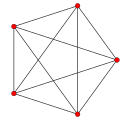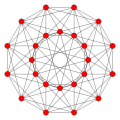4-polytope: Difference between revisions
| Line 38: | Line 38: | ||
;Sectioning |
;Sectioning |
||
Just as a slice through a polyhedron reveals a cut surface, so a slice through a polychoron reveals a cut "hypersurface" in three dimensions. A sequence of such sections can be used to build up an understanding of the overall shape. |
Just as a slice through a polyhedron reveals a cut surface, so a slice through a polychoron reveals a cut "hypersurface" in three dimensions. A sequence of such sections can be used to build up an understanding of the overall shape. The extra dimension can be equated with time to produce a smooth animation of these cross sections. |
||
== Euler characteristic == |
== Euler characteristic == |
||
Revision as of 20:20, 4 October 2013
 4-simplex (5-cell) |
 4-orthoplex (16-cell) |
 4-cube (8-cell, Tesseract) |
 24-cell |
 120-cell |
 600-cell |

In geometry, a polychoron or 4-polytope is a four-dimensional polytope.[1][2] It is a connected and closed figure, composed of lower dimensional polytopal elements: vertices, edges, faces (polygons), and cells (polyhedra). Each face is shared by exactly two cells.
The term polychoron (plural polychora), from the Greek roots poly ("many") and choros ("room" or "space") and has been advocated by Norman Johnson and George Olshevsky in the context of uniform polychora,[3] Other names for 4-polytopes include polyhedroid and polycell.
The two-dimensional analogue of a polychoron is a polygon, and the three-dimensional analogue is a polyhedron.
Topologically 4-polytopes are closely related to the uniform honeycombs, such as the cubic honeycomb, which tessellate 3-space; similarly the 3D cube is related to the infinite 2D square tiling. Convex 4-polytopes can be cut and unfolded as nets in 3-space.
Definition
Polychora are closed four-dimensional figures. The most familiar example of a polychoron is the tesseract or hypercube, the 4D analogue of the cube. A tesseract has vertices, edges, faces, and cells. A vertex is a point where four or more edges meet. An edge is a line segment where three or more faces meet, and a face is a polygon where two cells meet. A cell is the three-dimensional analogue of a face, and is therefore a polyhedron. Furthermore, the following requirements must be met:
- Each face must join exactly two cells.
- Adjacent cells are not in the same three-dimensional hyperplane.
- The figure is not a compound of other figures which meet the requirements.
Visualisation
Polychora can not be seen in three-dimensional space due to their extra dimension. Several techniques are used to help visualise them.
- Projection
Just as a 3D shape can be projected onto a flat sheet, so a 4-D shape can be projected onto 3-space or even onto a flat sheet. One common projection is a Schlegel diagram which uses Stereographic projection of points on the surface of a 3-sphere into three dimensions, connected by straight edges, faces, and cells drawn in 3-space.
- Sectioning
Just as a slice through a polyhedron reveals a cut surface, so a slice through a polychoron reveals a cut "hypersurface" in three dimensions. A sequence of such sections can be used to build up an understanding of the overall shape. The extra dimension can be equated with time to produce a smooth animation of these cross sections.
Euler characteristic
The Euler characteristic for 4-polytopes that are topological 3-spheres (including all convex 4-polytopes) is zero. χ=V-E+F-C=0.
For example, the convex regular 4-polytopes:
| Name | Schläfli symbol |
Vertices | Edges | Faces | Cells | χ |
|---|---|---|---|---|---|---|
| 5-cell | {3,3,3} | 5 | 10 | 10 | 5 | 0 |
| 16-cell | {3,3,4} | 8 | 24 | 32 | 16 | 0 |
| tesseract | {4,3,3} | 16 | 32 | 24 | 8 | 0 |
| 24-cell | {3,4,3} | 24 | 96 | 96 | 24 | 0 |
| 120-cell | {5,3,3} | 600 | 1200 | 720 | 120 | 0 |
| 600-cell | {3,3,5} | 120 | 720 | 1200 | 600 | 0 |
Classification
Like all polytopes, polychora may be classified based on properties like "convexity" and "symmetry".
- A polychoron is convex if its boundary (including its cells, faces and edges) does not intersect itself and the line segment joining any two points of the polychoron is contained in the polychoron or its interior; otherwise, it is non-convex. Self-intersecting polychora are also known as star polychora, from analogy with the star-like shapes of the non-convex star polygons and Kepler–Poinsot polyhedra.
- A polychoron is regular if it is transitive on its flags. This means that its cells are all congruent regular polyhedra, and similarly its vertex figures are congruent and of another kind of regular polyhedron.
- A uniform polychoron is semi-regular if it has a symmetry group under which all vertices are equivalent and its cells are regular polyhedra. The cells may be of two or more kinds, provided that they have the same kind of face. There are only 3 cases identified by Thorold Gosset in 1900: the rectified 5-cell, rectified 600-cell, and snub 24-cell.
- A polychoron is uniform if it has a symmetry group under which all vertices are equivalent, and its cells are uniform polyhedra. The faces of a uniform polychoron must be regular.
- A regular polychoron which is also convex is said to be a convex regular polychoron.
- A polychoron is prismatic if it is the Cartesian product of two lower-dimensional polytopes. A prismatic polychoron is uniform if its factors are uniform. The hypercube is prismatic (product of two squares, or of a cube and line segment), but is considered separately because it has symmetries other than those inherited from its factors.
- A tiling of 3-space is the division of three-dimensional Euclidean space into a repetitive grid of polyhedral cells. Such tilings or tessellations are infinite and do not bound a "4D" volume, and are examples of infinite polychora or apeirochora. A uniform tiling of 3-space is one whose vertices are congruent and related by a space group and whose cells are uniform polyhedra.
Categories
The following lists the various categories of polychora classified according to the criteria above:
Uniform polychora (vertex-transitive):
- Convex uniform polychora (64, plus two infinite families)
- 47 non-prismatic convex uniform polychora including:
- Prismatic uniform polychora:
- {} x {p,q} : 18 polyhedral hyperprisms (including cubic hyperprism, the regular hypercube)
- hyperprisms built on antiprisms (infinite family)
- {p} x {q} : Duoprisms (infinite family)
- Non-convex uniform polychora (10 + unknown)
- 10 (regular) Schläfli-Hess polychora
- 57 hyperprisms built on nonconvex uniform polyhedra
- Unknown total number of nonconvex uniform polychora: The Uniform Polychora Project now counts 1849 known cases.
Other convex polychora:
- Polyhedral pyramid - self-dual
- Polyhedral prism
- Polyhedral antiprism
Infinite uniform polychora of Euclidean 3-space (uniform tessellations of convex uniform cells)
- 28 convex uniform honeycombs: uniform convex polyhedral tessellations, including:
- 1 regular tessellation, cubic honeycomb: {4,3,4}
Infinite uniform polychora of hyperbolic 3-space (uniform tessellations of convex uniform cells)
- 76 Wythoffian convex uniform honeycombs in hyperbolic space, including:
- 4 regular tessellation of hyperbolic space: {3,5,3}, {4,3,5}, {5,3,4}, {5,3,5}
Dual uniform polychora (cell-transitive):
- 41 unique dual convex uniform 4-polytopes
- 17 unique dual convex uniform polyhedral prisms
- infinite family of dual convex uniform duoprisms (irregular tetrahedral cells)
- 27 unique convex dual uniform honeycombs, including:
Others:
- Weaire-Phelan structure periodic space-filling honeycomb with irregular cells
These categories include only the polychora that exhibit a high degree of symmetry. Many other polychora are possible, but they have not been studied as extensively as the ones included in these categories.
See also
- Convex regular 4-polytope
- The 3-sphere (or glome) is another commonly discussed figure that resides in 4-dimensional space. This is not a polychoron, since it is not bounded by polyhedral cells.
- The duocylinder is a figure in 4-dimensional space related to the duoprisms. It is also not a polychoron because its bounding volumes are not polyhedral.
Footnotes
- ^ Vialar, T. (2009). Complex and Chaotic Nonlinear Dynamics: Advances in Economics and Finance. Springer. p. 674. ISBN 978-3-540-85977-2.
- ^ Capecchi, V. (2010). Applications of Mathematics in Models, Artificial Neural Networks and Arts. Springer. p. 598. doi:10.1007/978-90-481-8581-8. ISBN 978-90-481-8580-1.
{{cite book}}: Unknown parameter|coauthors=ignored (|author=suggested) (help) - ^ "Convex and abstract polytopes, Thursday, May 19, 2005 to Saturday, May, 21, 2005", Programme and abstracts, MIT, 2005. [1]
References
- T. Gosset: On the Regular and Semi-Regular Figures in Space of n Dimensions, Messenger of Mathematics, Macmillan, 1900
- A. Boole Stott: Geometrical deduction of semiregular from regular polytopes and space fillings, Verhandelingen of the Koninklijke academy van Wetenschappen width unit Amsterdam, Eerste Sectie 11,1, Amsterdam, 1910
- H.S.M. Coxeter:
- H. S. M. Coxeter, M. S. Longuet-Higgins and J. C. P. Miller: Uniform Polyhedra, Philosophical Transactions of the Royal Society of London, Londne, 1954
- H.S.M. Coxeter, Regular Polytopes, 3rd Edition, Dover New York, 1973
- Kaleidoscopes: Selected Writings of H.S.M. Coxeter, editied by F. Arthur Sherk, Peter McMullen, Anthony C. Thompson, Asia Ivic Weiss, Wiley-Interscience Publication, 1995, ISBN 978-0-471-01003-6 [2]
- (Paper 22) H.S.M. Coxeter, Regular and Semi Regular Polytopes I, [Math. Zeit. 46 (1940) 380-407, MR 2,10]
- (Paper 23) H.S.M. Coxeter, Regular and Semi-Regular Polytopes II, [Math. Zeit. 188 (1985) 559-591]
- (Paper 24) H.S.M. Coxeter, Regular and Semi-Regular Polytopes III, [Math. Zeit. 200 (1988) 3-45]
- J.H. Conway and M.J.T. Guy: Four-Dimensional Archimedean Polytopes, Proceedings of the Colloquium on Convexity at Copenhagen, page 38 und 39, 1965
- N.W. Johnson: The Theory of Uniform Polytopes and Honeycombs, Ph.D. Dissertation, University of Toronto, 1966
- Four-dimensional Archimedean Polytopes (German), Marco Möller, 2004 PhD dissertation [3]
External links
- Weisstein, Eric W. "Polychoron". MathWorld.
- Weisstein, Eric W. "Polyhedral formula". MathWorld.
- Weisstein, Eric W. "Regular polychoron Euler characteristics". MathWorld.
- Four dimensional figures page, George Olshevsky.
- Olshevsky, George. "Polychoron". Glossary for Hyperspace. Archived from the original on 4 February 2007.
- Uniform Polychora, Jonathan Bowers
- Uniform polychoron Viewer - Java3D Applet with sources
- Dr. R. Klitzing, polychora
